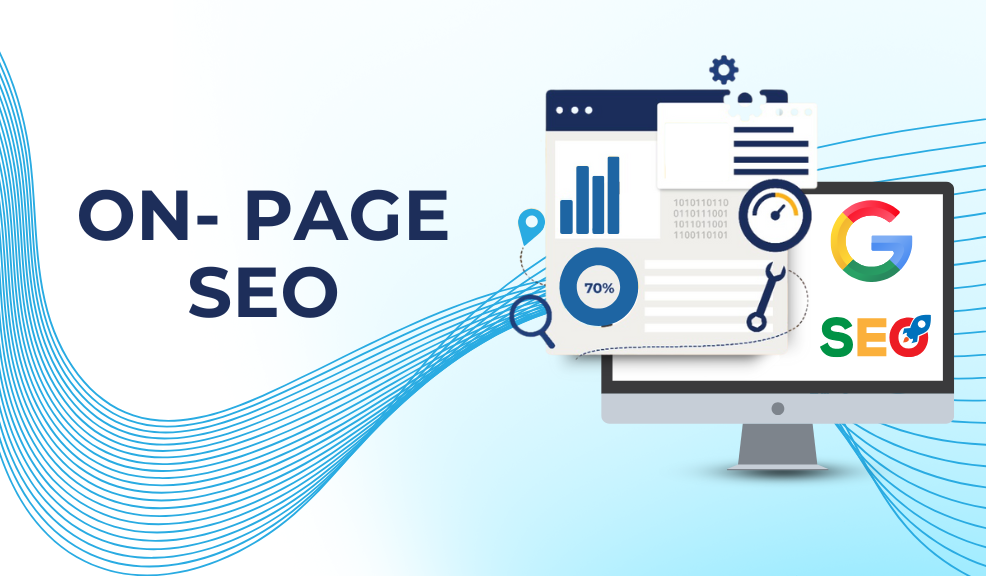On-page optimization is a crucial aspect of Search Engine Optimization (SEO) that focuses on optimizing elements within your website to improve its search engine rankings and user experience. Unlike off-page SEO, which deals with external factors like backlinks, on-page SEO ensures that your website is structured, written, and formatted to align with Google’s ranking factors.
In this guide, we’ll explore what on-page optimization is, why it matters, and the key strategies to implement for higher rankings on Google.
What is On-Page Optimization?
On-page SEO refers to all the measures taken within a website to improve its position in search engine results pages (SERPs). This includes optimizing content, HTML elements, site structure, and technical settings to make it easier for search engines to crawl and index your site.
Why is On-Page Optimization Important?
- Better Search Rankings: Well-optimized pages rank higher in search results.
- Improved User Experience: Optimized sites provide better navigation and readability.
- Higher Click-Through Rates (CTR): Effective meta titles and descriptions attract more visitors.
- Increased Engagement & Conversions: Faster load times and relevant content improve user retention.
Key On-Page SEO Elements to Optimize
To rank higher on Google, you must optimize multiple on-page factors that influence search engine rankings.
1. Keyword Research & Optimization
Keywords are the foundation of SEO. Optimize your content for high-intent, relevant keywords that match your target audience’s search queries.
- Use Google Keyword Planner, Ahrefs, or SEMrush for keyword research.
- Focus on long-tail keywords to attract targeted traffic.
- Place keywords naturally and organically in:
- Title Tags
- Headings (H1, H2, H3, etc.)
- Meta Descriptions
- First 100 Words
- Image Alt Text
- URL Structure
Please do not insert keywords forcefully that may hamper the web-page reading experience for the website visitors. The keywords should be there in the above HTML tags organically.
2. Optimized Title Tags
Title tags (H1 tags) are one of the most important ranking factors.
- The text in the Title tag is visible and in the search results and if users see the match with their searching keywords, they are most likely to click on the webpage. You can Keep title tags under 60 characters.
- Include your primary keyword at the beginning.
- Make it engaging to improve CTR.
- H1 tag is for the headline and generates interest to the users for reading the page further. The presence of searching keywords gives confidence to the users.
Example: Best Digital Marketing Strategies for 2025 | Expert SEO Tips
3. Meta Descriptions
Meta descriptions provide a summary of your page and influence CTR.
- Keep them between 150-160 characters.
- Include primary keywords naturally.
- Write compelling descriptions to encourage clicks.
Example: Learn the best digital marketing strategies for 2024. Increase your rankings with expert SEO tips and proven techniques.
4. Header Tags (H1, H2, H3, etc.)
Proper heading structure improves readability and SEO.
- Use H1 for the main page title.
- Use H2 and H3 for subheadings to organize content.
- Include keywords naturally in headings.
5. URL Structure Optimization
SEO-friendly URLs improve rankings and user experience.
- Keep URLs short and descriptive.
- Use hyphens (-) instead of underscores (_).
- Include keywords in URLs.
Example: ✅ www.example.com/seo-strategies-2024
Avoid: ❌ www.example.com/article?id=12345
6. Internal Linking
Internal links help search engines understand site structure and pass link authority.
- Link relevant pages within your website.
- Use descriptive anchor text instead of generic text like “click here.”
- Ensure each page is connected to other important pages.
7. Image Optimization & Alt Text
Search engines cannot read images, so optimize them with alt text.
- Use descriptive filenames (e.g., digital-marketing-strategy.jpg).
- Add alt text that describes the image.
- Compress images for faster loading speeds (Use tools like TinyPNG).
8. Mobile-Friendliness & Responsive Design
Since Google’s Mobile-First Indexing, mobile-friendly websites rank higher.
- Use responsive design for all screen sizes.
- Test your site on Google’s Mobile-Friendly Test.
- Ensure buttons and links are easily clickable on mobile.
9. Page Load Speed & Core Web Vitals
Google considers page speed a ranking factor. Improve load time by:
- Compressing images and using next-gen formats (WebP).
- Reducing unnecessary JavaScript and CSS files.
- Using a Content Delivery Network (CDN) for faster content delivery.
- Testing speed with Google PageSpeed Insights.
10. Schema Markup (Structured Data)
Schema markup helps search engines understand your content.
- Add structured data for reviews, articles, events, FAQs, etc.
- Use Google’s Structured Data Testing Tool to check implementation.
- Example: Product pages with star ratings and pricing appearing in search results.
11. Improve User Engagement (Dwell Time & Bounce Rate)
Google monitors how long users stay on your website.
- Write engaging, valuable content that keeps users on your site.
- Use videos, infographics, and visuals to enhance content.
- Add clear call-to-actions (CTAs) to encourage interaction.
Advanced On-Page SEO Techniques
1. Content Clusters & Topic Authority
- Instead of single keyword-focused pages, create content hubs.
- Example: A pillar post on “Digital Marketing” with internal links to related topics like SEO, PPC, and social media marketing.
2. Voice Search Optimization
- Use natural language and conversational keywords.
- Optimize for questions and featured snippets (e.g., “What is on-page SEO?”).
3. AI-Powered SEO Strategies
Using AI-driven tools like Algo Ranke AI SEO can automate and enhance on-page SEO:
- AI-generated keyword research & content suggestions.
- AI-driven user engagement analysis to lower bounce rates.
- AI-powered search traffic & ranking improvements.
4. Master On-Page Optimization for Higher Rankings
On-page optimization is the foundation of SEO success. By implementing these strategies, you can enhance user experience, improve rankings, and drive more organic traffic to your site. Whether it’s optimizing title tags, improving page speed, or leveraging AI-powered SEO, staying ahead in SEO requires continuous updates and testing.
